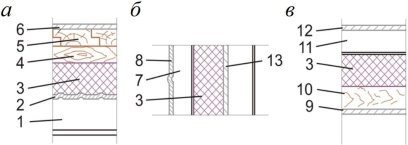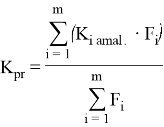The paper describes the need to increase the number of units of refrigerated rolling stock with improved technical and economic indicators. The analysis of thermal insulation materials of the structures of the fencing of the bodies of refrigerated cars is given. To calculate the heat transfer coefficients of enclosing structures, the approximate method of elementary sections was used. To reduce the heat transfer coefficient and the thickness of the body guard, it is necessary to use more efficient materials with low thermal conductivity.
Keywords: heat transfer coefficient, thermal conductivity, heat transfer, isothermal rolling stock.
I. Introduction
The geographical location and specific climate of the Republic of Uzbekistan — aridity, high solar temperature, continental climate — contribute to the mass production of fruits and vegetables, as well as high yields of fruits, berries and vegetables, which not only satisfies the needs of the domestic market, but also the supply of perishable products to the markets of the CIS countries.
For the export of fruits and vegetables, a sufficiently large number of vehicles are needed, equipped with the necessary thermal insulation and refrigeration and heating installations.
II. Literature review
The effective functioning and development of refrigerated railway transport in the Republic of Uzbekistan plays a special role in the creation and development of the national economy. JSC «Yulreftrans» is the only refrigerated base in the Republic of Uzbekistan, which should ensure the transportation of perishable goods.
As of the beginning of 2021, the inventory fleet balance of Yulreftrans JSC includes 1,293 refrigerator cars, 3 autonomous refrigerator cars (ARV), 107 thermos cars and 169 thermos cars converted from covered cars. The fleet of wagons is quite worn out and needs repair and modernization. Freight cars can be upgraded for thermos cars with reinforced body railing.
III. Analysis
In the design of the thermal fencing of the body, the thermal properties of the heat-insulating material play a significant role. In operated refrigerated cars and containers, the thickness of walls, roofs and floors reaches up to 250 mm, which leads to an increase in weight and a decrease in the internal dimensions and useful volume of the body. The reason for this is the imperfection of technical solutions for the construction of body fencing structures and thermal insulation materials. During operation, the insulation of the body fencing ages, wears out due to the effects of vibration, temperature changes and humidity. The deterioration of the quality of insulation of fences leads to excessive fuel consumption and an increase in financial costs, and the volume of repair work increases during scheduled types of repairs. Characteristics of body guard elements are given in Table 1.
For thermal insulation of insulated cars, different materials are used, which are presented in table 2.
To calculate the heat transfer coefficients of enclosing structures in construction and car building, the approximate method of elementary sections, which is simpler than other methods, has been used. Calculation of the heat transfer coefficient by the method of elementary sections is carried out in two steps.
The first one provides for the division of the structure by non-heat-conducting planes parallel to the heat flow into parts consisting from one or more homogeneous layers perpendicular to the direction of the heat flow.
Table 1
Materials and layer thicknesses δ of the fence of various types of isothermal rolling stock
|
Wagon type |
Floor |
Side wall |
End wall |
Roof |
|
Freight refrigerated 5-car section (ZB-5) |
δ 1 =2 mm galvanized. steel |
δ 1 =2.5 mm steel |
δ 1 =3 mm steel |
δ 1 =2.5 mm steel |
|
δ 1 =48 mm wood |
δ 1 =193 mm mipore |
δ 1 =193 mm mipore |
δ 1 =236 mm mipore |
|
|
δ 1 =236 mm mipore |
δ 3 =2 mm steel |
δ 4 =2 mm steel |
δ 3 =309.5 mm air |
|
|
δ 4 =2 mm steel |
δ 3 =309.5 mm air |
|||
|
Freight refrigerated 5-car section (BMZ) |
δ 1 =4 mm rubber |
δ 1 =2 mm steel |
δ 1 =2 mm steel |
δ 1 =2 mm steel |
|
δ 1 =45 mm wood |
δ 1 =217 mm PSB-S |
δ 1 =290 mm PSB-S |
δ 1 =234 mm PSB-S |
|
|
δ 3 =185 mm PSB-S |
δ 3 =2 mm AMG-6 |
δ 3 =2 mm AMG-6 |
δ 3 =135 mm air |
|
|
δ 4 =2 mm steel |
δ 4 =4 mm fiberboard |
|||
|
δ 1 =4 mm rubber |
δ 1 =1.5 mm steel |
δ 1 =1.5 mm steel |
δ 1 =1.5 mm steel |
|
|
δ 1 =40÷60 mm wood |
δ 1 =200 mm PSB-S |
δ 1 =200 mm PSB-S |
δ 1 =250 mm PSB-S |
|
|
δ 3 =140 mm PSB-S |
δ 3 =2 mm galv. steel |
δ 3 =2 mm galv. steel |
δ 3 =385.5 mm air |
|
|
δ 4 =2 mm steel |
δ 4 =4 mm joiner. plate |
|||
|
δ 1 =4 mm rubber |
δ 1 =1.5 mm steel |
δ 1 =1.5 mm steel |
δ 1 =1.5 mm steel |
|
|
δ 1 =40÷60 mm fiberglass |
δ 1 =200 mm AMG-6 |
δ 1 =200 mm AMG-6 |
δ 1 =250 mm AMG-6 |
|
|
δ 3 =18mm plywood |
δ 3 =2 mm galv. Steel |
δ 3 =2 mm galv. Steel |
δ 3 =385.5 mm air |
|
|
δ 4 =2 mm steel |
δ 4 =0.75 mm Ecosteel |
Table 2
Thermal conductivity coefficient λ for various materials
|
Linoleum |
Coefficient of thermal conductivity λ, W/( m ⋅К) |
|
Blockboard |
0,174 |
|
Polystyrene PSB-S |
0,22 |
|
Polyethylene foam |
0,038 |
|
Steel |
0,028–0,06 |
|
Plastic-povinol |
46,4 |
|
Air |
0,174 |
|
Mypora |
0,0232 |
|
Aluminum sheet AMG-6 |
0,035 |
|
fiberboard |
142,68 |
|
Rubber |
0,22 |
|
Tree |
0,197 |
|
low alloy steel |
0,232 |
|
Plywood |
33–35 |
|
Fiberglass |
0,15 |
|
Linoleum |
0,35–0,45 |
Examples of delimiting a structure into parts consisting of homogeneous layers are shown in Picture 1.
Material name

Fig. 1. The device for thermal insulation of an insulated car: a — floor; b — wall; c — roof; 1 — transverse beam of the car; 2 — metal corrugated sheet; 3 — thermal insulation; 4 — wooden cross beam; 5 — upper flooring; 6 — galvanized sheet; 7 — vertical stand of the wall; 8 — outer steel sheathing; 9 — ceiling lining; 10 — wooden ceiling arc; 11 — steel ceiling arc; 12 — steel roof sheathing; 13 — steel inner lining with vertical corrugations
To determine the reduced heat transfer coefficient of the railing of the car body, the actual heat transfer coefficients of individual elements of the railing (roof, floor, windows, walls) are first calculated using the formula

where 𝑎 n is the heat transfer coefficient on the outer surface of the railing of the car body, W/(m 2 ∙ K); 𝛿𝑖𝑗 is the thickness of the j -th layer of the i -th body element, m;
𝜆𝑖𝑗 — coefficient of thermal conductivity of the material of the corresponding layer of the fence, W/(m 2 ∙ K); 𝑎в𝑖 — heat transfer coefficient on the inner surface of the enclosure of the i-th element of the body, W/(m 2 ∙ K).

where 𝑎 is a coefficient that takes into account radiant heat transfer (for summer
conditions a = 9, W/(m 2 ∙ K)); 𝑣 is the speed of the car, km/h; L 1 is the length of the guarded part of the car body, m.
For refrigerated wagons inside the cargo space, the following values of the heat transfer coefficient are accepted:
– near the floor 𝑎в = 6 W/(m 2 ∙ K);
– near the walls 𝑎в = 10 W/(m 2 ∙ K);
– near roofs 𝑎в = 9 W/(m 2 ∙ K).
The car body inside has longitudinal and transverse elements rigidity made of steel. In their locations, thermal bridges are created that increase the heat transfer coefficients of the fencing elements. During the operation of the car, gaps may appear between the layers of the body guard.
IV. Discussion
These factors should be taken into account by increasing the values of the coefficients 𝐾 𝑖 fact . refrigerated wagons by 50 %. This is how the values of 𝐾 𝑖 calc are calculated. for isothermal wagons
𝐾 𝑖 calc . = 1.5 ∙ 𝐾 𝑖 fact , W/(m 2 ∙K).
The reduced heat transfer coefficient of the railing of the car is found taking into account the areas of the railing and the values of 𝐾 𝑖 calc .

In, the value of 𝐾 pr should not exceed the excess for refrigerated cars of 0.36 W/(m 2 ∙ K). The calculation results are presented in Table 3.
Table 3
Results of calculations of the heat transfer coefficient K
|
Type of isothermal rolling stock |
Heat transfer coefficient K , W/(m 2 ∙ K) |
|
Freight refrigerated 5-car section (ZB-5) |
0,401 |
|
Autonomous refrigerated wagon (ARV), |
0,382 |
|
Freight refrigerated 5-car section (BMZ) |
0,397 |
|
Thermos car |
0,373 |
V. Conclusion
The results of the calculations showed that the heat transfer coefficient of the fences of the existing isothermal cars, with the specified thickness of the heat-insulating layer and the material used, is relatively high. Therefore, in order to reduce the heat transfer coefficient and the thickness of the body guard, it is necessary to use more efficient materials with low thermal conductivity.
References:
- Abdullaev B. A. Selection of directions and technical solutions of rolling stock for the transportation of perishable goods in the conditions of the Republic of Uzbekistan: dis. cand. tech. Sciences: 05.22.07 / B. A. Abdullaev. — St. Petersburg: PGUPS, 2020. — 117 p.
- Abdullaev B. A. Analysis and prospects for the development of transportation of perishable goods in the Republic of Uzbekistan / B. A. Abdullaev // Collection of abstracts of the National Scientific and Technical Conference «Prospects for the future in the educational process». — St. Petersburg: PGUPS, 2020. — Pp. 10–13.
- Faizibaev Sh.S. Analysis and prospects for the development of transportation of perishable goods in the Republic of Uzbekistan / Sh.S. Faizibaev, B. A. Abdullaev // Bulletin of transport of the Volga region. — 2019, — No. 3 (75). — Pp. 63–69.







